Glencoe Math Course 3 Volume 2 Student Chapter 6 Transformations Exercise 6.1
Page 453 Exercise 1 Problem1
We have to show the best possible way to describe the change in position of a figure. We can show or describe the change in position of a figure by changing the direction and moving from one place to another.
Changing the direction and moving from one place to another is the best possible way to describe a figure.
Page 454 Exercise 1 Problem1
The given statement is, graph ΔABC with vertices A(4,−3), B(0,2), and C(5,1).
Then graph the image of ΔABC after each translation, and write the coordinates of its vertices. We have to determine the coordinates of the vertices of the figure at the direction of 4 units left and 3 units up.
We add the ordered pair of shifting the direction(−4,3) to the coordinates of each vertex of the given figure to obtain the new vertices and their coordinates.
We have the given figure ΔABC with vertices A(4,−3), B(0,2), and C(5,1) in the X−Y plane.
Now, we plot the figure in the graph,
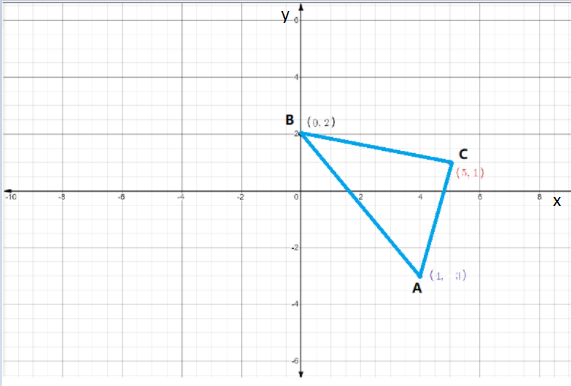
Now, to translate the figure towards 4 units left and 3 units up, we add(−4,3) to all the vertex coordinates of the figure as,

We have calculated the new coordinates of vertices of the translated figure as A′(0,0), B′(−4,5), C′(1,4).
Therefore, we can draw the figure as
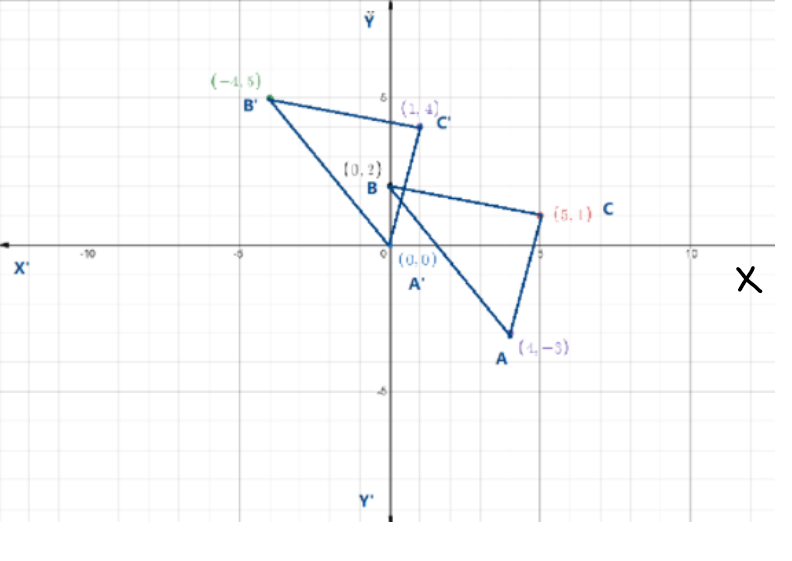
Finally, we can conclude that the new coordinates of the figure are A′(0,0), B′(−4,5), C′(1,4).
Page 451 Exercise 1 Problem2
The given statement is graph quadrilateral ABCD with vertices, A(0,0), B(2,0), C(3,4), and D(0,4).
Then graph the image of ABCD after each translation, and write the coordinates of its vertices.
We have to determine the coordinates of the vertices of the figure at the direction of 4 units right and 2 units down. We add the ordered pair of shifting the direction(4,−2) to the coordinates of each vertex of the given figure to obtain the new vertices and their coordinates.
We have the given figure quadrilateral ABCD with vertices A(0,0), B(2,0), C(3,4), and D(0,4) in the theX−Yplane.
Now, we plot the figure in the graph,
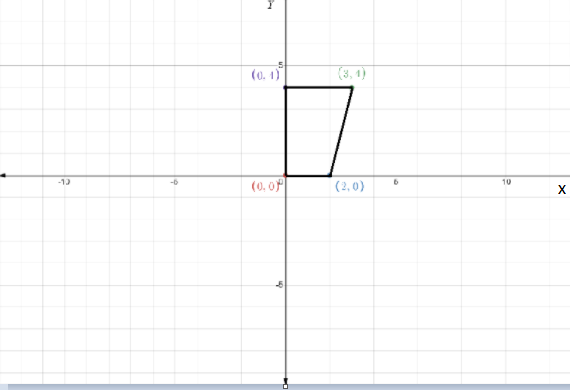
Now, to translate the figure towards 4 units right and 2 units down, we add(4,−2) to all the vertex coordinates of the figure as,

We have calculated the new coordinates of vertices of the translated figure as A′ (4,−2), B′ ((6,−2), C′ (7,2), D′ (4,2).
Therefore, we can draw the figure as,
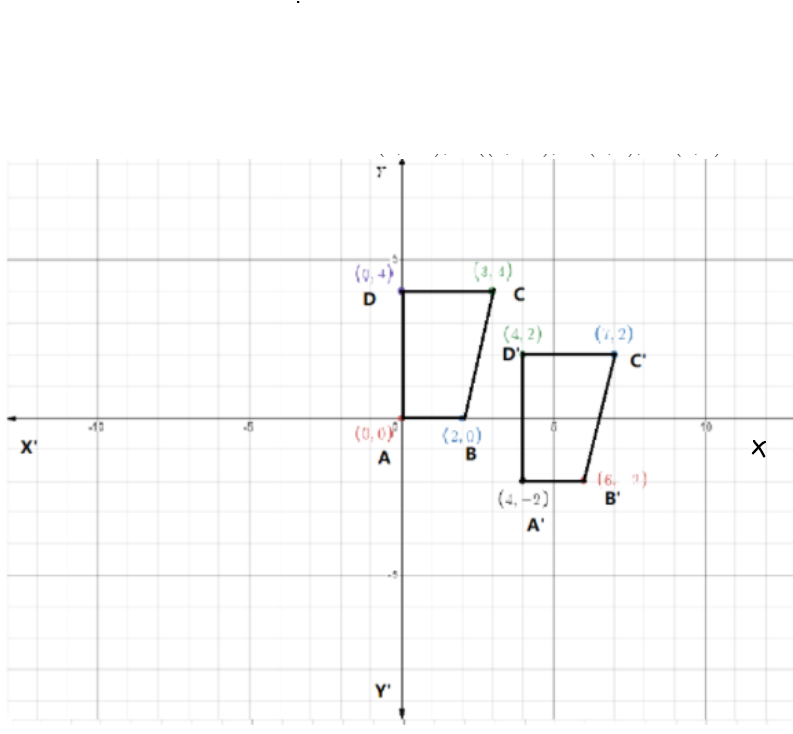
Finally, we can conclude that the new coordinates of the figure areA′(4,−2), B′((6,−2), C′(7,2), D′(4,2)
Page 454 Exercise 1 Problem3
The translation is defined as the relocation of the figure to a different coordinate creating an exact replica of it. Let us consider that the figure is given as follows.
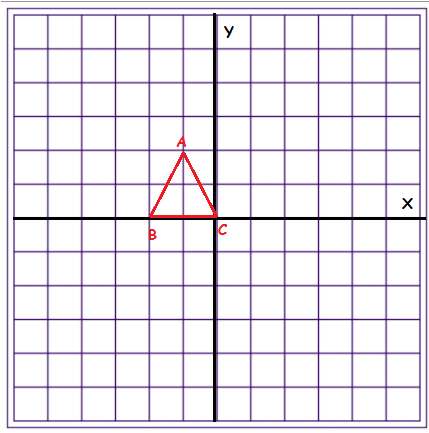
If we need to translate it to 2 units right, we have to shift the coordinates to two units positive of the x-axis as shown.

The translation is defined as the relocation of the figure to a different coordinate creating an exact replica of it. An example is given below,

Page 456 Exercise 1 Problem1
The given statement is, graph ΔXYZ with vertices X(-4,-4), Y(-3,-1), and Z(2,-2).
Then graph the image of ΔXYZ after each translation, and write the coordinates of its vertices.
We have to determine the coordinates of the vertices of the figure at the direction of 3 units right and 4 units up.
We add the ordered pair of shifting the direction (3,4) to the coordinates of each vertex of the given figure to obtain the new vertices and their coordinates.
We have the given figure ΔXYZ with vertices X(-4,-4), Y(-3,-1), and Z(2,-2) in the X-Y plane. Now, we plot the figure in the graph,
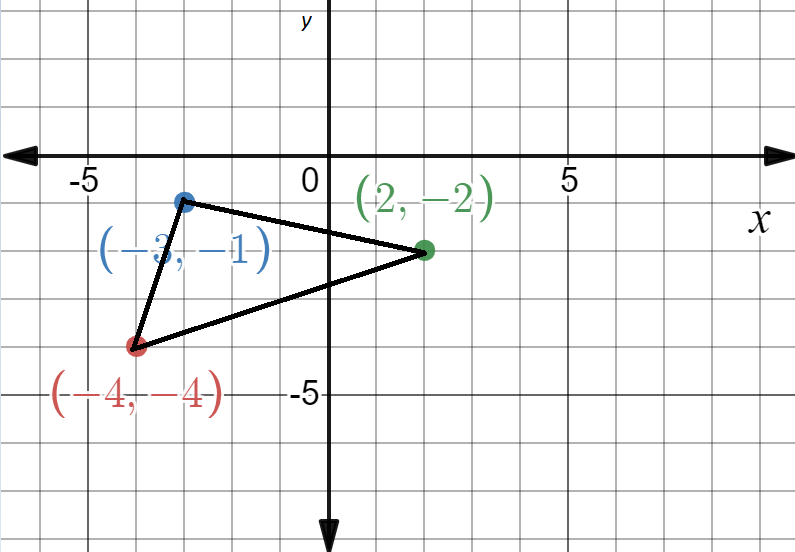
Now, to translate the figure towards 3 units right and 4 units up, we add (3,4) to all the vertex coordinates of the figure as,

Now, to translate the figure towards 3 units right and 4 units up, we add (3,4) to all the vertex coordinates of the figure as,
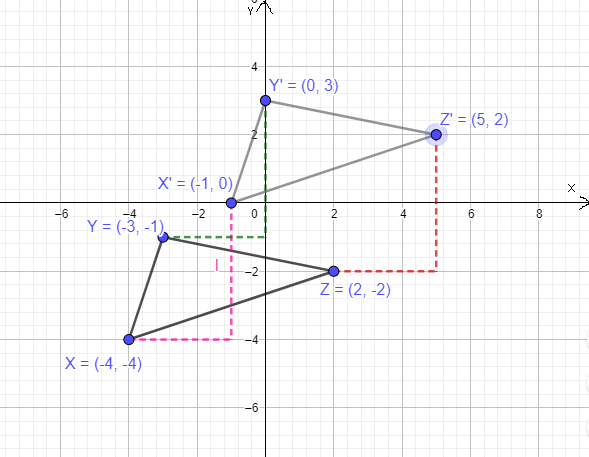
Finally, we can conclude that the new coordinates of the figure are X(-1,0), Y(0,3), and Z(5,2).
Page 456 Exercise 2 Problem1
The given statement is, graph ΔXYZ with vertices X(-4,-4), Y(-3,-1), and Z(2,-2).
Then graph the image of ΔXYZ after each translation, and write the coordinates of its vertices.
We have to determine the coordinates of the vertices of the figure in the direction of 2 units left and 3 units down.
We add the ordered pair of shifting the direction (-2,-3) to the coordinates of each vertex of the given figure to obtain the new vertices and their coordinates.
We have the given figure ΔXYZ with vertices X(-4,-4), Y(-3,-1), and Z(2,-2) in the X-Y plane. Now, we plot the figure in the graph

Now, to translate the figure towards 2 units left and 3 units down, we add (-2,-3) to all the vertex coordinates of the figure as,
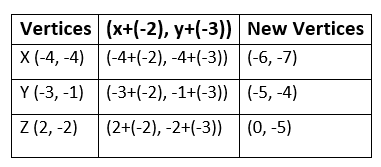
We have calculated the new coordinates of vertices of the translated figure as X(-6,-7), Y(-5,-4), and Z(0,-5). Therefore, we can draw the figure as,
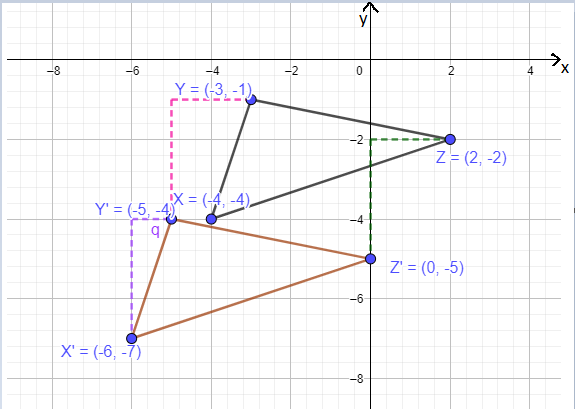
Finally, we can conclude that the new coordinates of the figure are X(-6,-7), Y(-5,-4), and Z(0,-5).
Page 456 Exercise 3 Problem1
The given statement is, The baseball at the right was filmed using stop-motion animation so it appears to be thrown in the air. Use translation notation to describe the translation from point A to point B.
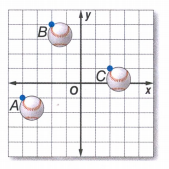
We modify the X and Y coordinates of point A according to the horizontal change and vertical change respectively with respect to point B.
We have the given figure as,
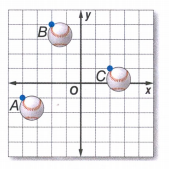
Now, we can see from the figure the coordinates of point A is (-4,-1) and coordinates of point B is (-2,4).
We assume, let there be a change of a units in the horizontal axis (X) and b units change in the vertical axis (Y).
Hence, the changed coordinates will be (x+a, y+b) and as the changed point is B, so we can write,⟨x+a,y+b)→(−2,4) and we know that for point A x= -4 and y= -1. Thus, ⟨−4+a,−1+b)→(−2,4).
So, we compare the x-coordinates as, −4+a=−2
⇒ a=−2+4
⇒ a=2.
Hence, the horizontal translation is of +2 units i.e. 2 units in the right direction.
We also compare the y-coordinates as, −1+b=4
⇒ b=4+1
⇒ b=5.
Hence, the vertical translation is of +5 units i.e. 5 units in the up direction. We can show it in the graph as,
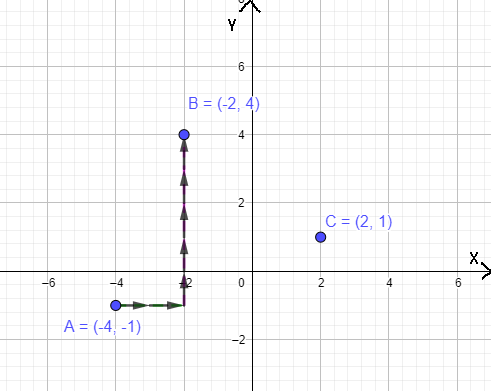
Finally, we can conclude that the translation from point A to B is (x+2,y+5) i.e. 2 units right and 5 units up.
Page 456 Exercise 4 Problem1
The given statement is, Quadrilateral DEFG has vertices at D(1,0), E(-2,-2), F(2,4), and G(6,-3).
We have to find the vertices of D′E′F′G′after a translation of 4 units right and 5 units down.
We add the ordered pair of shifting the direction (4,-5) to the coordinates of each vertex of the given figure to obtain the new vertices and their coordinates.
We have the given figure quadrilateral DEFG with vertices D(1,0), E(-2,-2), F(2,4), and G(6,-3) in the X-Y plane.
Now, we plot the figure in the graph,
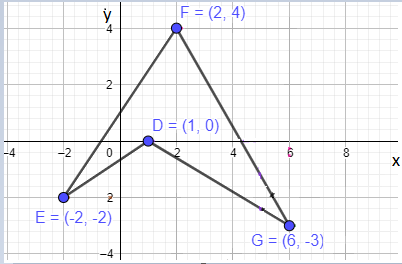
Now, to translate the figure towards 4 units right and 5 units down, we add (4,-5) to all the vertex coordinates of the figure as

We have calculated the new coordinates of vertices of the translated figure as D'(5,-5), E'(2,-7), F'(6,-1), and G'(10,-8). Therefore, we can draw the figure as,

Finally, we can conclude that the new coordinates of the figure are D'(5,-5), E'(2,-7), F'(6,-1), and G'(10,-8).
Page 456 Exercise 5 Problem1
Let us assume a triangle ΔABC with vertices A(0,0), B(4,0), and C(2,2). We slide this triangle 2 units right and 3 units down, what will be the coordinates of the new triangle ΔA′B′C′.
We add the ordered pair of shifting the direction (2,-3) to the coordinates of each vertex of the given figure to obtain the new vertices and their coordinates.
We have the triangle, ΔABC with vertices A(0,0), B(4,0), and C(2,2) in the X-Y plane. Now, we plot the figure in the graph,

Now, to translate the figure towards 2 units right and 3 units down, we add (2,-3) to all the vertex coordinates of the figure as,
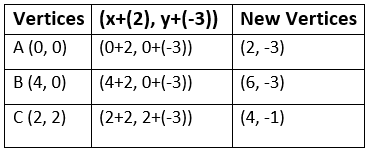
We have calculated the new coordinates of vertices of the translated figure as A'(2,-3), B'(6,-3), C'(4,-1). Therefore, we can draw the figure as,

Finally, we can conclude that the new coordinates of the figure are A'(2,-3), B'(6,-3), C'(4,-1).
Page 457 Exercise 1 Problem1
The given figure is, rectangle JKLM with vertices J(-3,2), K(3,5), L(4,3), and M(-2,0).
We have to determine the coordinates of each vertex for the translated figure as 1 unit right and 4 units down. We first draw the rectangle as per the given vertices and then translate each vertex of the figure to the required direction, which creates the translated figure.
We have a rectangle JKLM with vertices J(-3,2), K(3,5), L(4,3), and M(-2,0). We plot this as,

Now, as given, we have to translate the figure to 1 unit right and 4 units down.
So, we add (1,-4) to coordinate each vertex of the figure. Hence, the translated vertices are,
J′(−3+1,2+(−4))
→ J′(−2,−2),K′(3+1,5+(−4))
→ K′(4,1),L′(4+1,3+(−4))
→ L′(5,−1),M′(−2+1,0+(−4))
→ M′(−1,−4).
Therefore, we can plot the translated figure as,
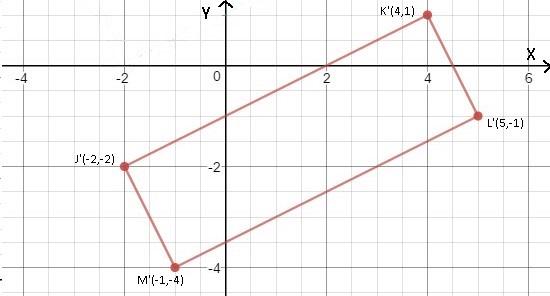
Finally, we can conclude that the vertices of the translated figure are J'(-2,-2), K'(4,1), L'(5,-1), and M'(-1,-4).

Page 457 Exercise 2 Problem1
The given figure is a triangle, ΔPQR which has vertices P(0,0), Q(5,-2), and R(-3,6).
We have to determine the coordinates of each vertex for the translated figure as 8 units left and 1 unit down.
We add the ordered pair of shifting the direction (-8,-1) to the coordinates of each vertex of the given figure to obtain the new vertices of the new triangle ΔP′Q′R′and their coordinates.
We have the figure ΔPQR with vertices P(0,0), Q(5,-2), and R(-3,6). We can plot it as,

Now, to translate the figure to 8 units left and 1 unit down, we have to add the ordered pair (-8,-1) with all the vertices of this figure to obtain the new coordinates.
So, we get the translated vertices as,
P′(0−8,0−1)→P′(−8,−1),
Q′(5−8,−2−1)→Q′(−3,3),
R′(−3−8,6−1)→R′(−11,5).
Hence, we can draw the translated triangle ΔP′Q′R′ as,

Finally, we can conclude that the vertices of the translated figure, towards 8 units left and 1 unit down is, P'(-8,-1), Q'(-3,3), R'(-11,5).

Page 457 Exercise 3 Problem1
The given statement is, Use translation notation to describe the translation from point A to point B.
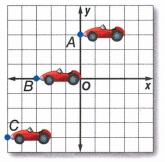
We modify the X and Y coordinates of point A according to the horizontal change and vertical change respectively with respect to point B.
We have the given figure as,

Now, we can see from the figure the coordinate of point A is (0,3) and the coordinate of point B is (-3,0).
We assume, let there be a change of a units in the horizontal axis (X) and b units change in the vertical axis (Y).
Hence, the changed coordinates will be (x+a, y+b) and as the changed point is B, so we can write, ⟨x+a,y+b)→(−3,0) and we know that for point A x= 0 and y= 3.
Thus, ⟨0+a,3+b)→(−3,0).
So, we compare the x-coordinates as, 0+a=−3,
⇒ a=−3.
Hence, the horizontal translation is of -3 units i.e. 3 units in the left direction.
We also compare the y-coordinates as, 3+b=0,
⇒ b=−3.
Hence, the vertical translation is of -3 units i.e. 3 units in the down direction.
Finally, we can conclude that the translation from point A to B is (x-3,y-3) i.e. 3 units left and 3 units down.
Page 457 Exercise 4 Problem1
The given statement is, Use translation notation to describe the translation from point B to point C.

We modify the X and Y coordinates of point B according to the horizontal change and vertical change respectively with respect to point C.
We have the given figure as,

Now, we can see from the figure the coordinate of point B is (-3,0) and the coordinate of point C is (-5,-4).
We assume, let there be a change of a units in the horizontal axis (X) and b units change in the vertical axis (Y).
Hence, the changed coordinates will be (x+a, y+b) and as the changed point is C, so we can write, ⟨x+a,y+b)→(−5,−4) and we know that for point B, x= -3 and y= 0.
Thus,⟨−3+a,0+b)→(−5,−4).
So, we compare the x-coordinates as, −3+a=−5,
⇒ a=−5+3
⇒ a=−2.
Hence, the horizontal translation is of -2 units i.e. 2 units in the left direction.
We also compare the y-coordinates as, 0+b=−4,
⇒ b=−4.
Hence, the vertical translation is of -4 units i.e. 4 units in the down direction.
Finally, we can conclude that the translation from point B to C is (x-2,y-4) i.e. 3 units left and 3 units down.
Page 457 Exercise 5 Problem1
The given statement, Quadrilateral KLMN has vertices K(-2,-2), L(1,1), M(0,4), and N(-3,5).
It is first translated by (x+2, y-1) and then translated by (x-3, y+4).
When a figure is translated twice, a double prime symbol is used.
We have to find the coordinates of quadrilateral K”L”M”N” after both translations.
We first add (2,-1) with all vertices of KLMN to translate it to K’L’M’N’.
We again translate the obtained figure K’L’M’N’ by adding (-3,4) to all vertices and obtain the final figure K”L”M”N”.
We have the given figure KLMN that has the vertices as K(-2,-2), L(1,1), M(0,4), and N(-3,5).
Now, we perform the translation (x+2, y-1) and obtain K’L’M’N’. hence, the translated coordinates are,
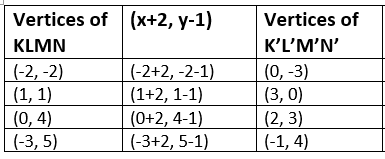
Now, we have the translated coordinates of K’L’M’N’ as K'(0,-3), L'(3,0), M'(2,3), and N'(-1,4).
We again perform the translation as (x-3, y+4) to obtain the coordinates of K”L”M”N”.
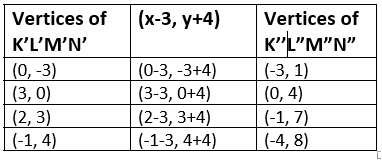
Therefore, the final translated coordinates are K”(-3,1), L'(0,4), M'(-1,7), and N'(-4,8).
Finally, we can conclude that the coordinates of quadrilateral K”L”M”N” after both translations are K”(-3,1), L'(0,4), M'(-1,7), and N'(-4,8).
Page 458 Exercise 6 Problem1
The given statement is, make a model with mathematics refers to the graphic novel frame below. List the five steps the girls should take and identify any transformations used in the dance steps.
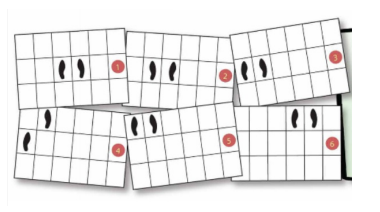
We compare the position of the right and the left leg in the previous step with the next step to determine the transformation step.
We have the given figure with 6 positions as,

Now, starting from the first position, to reach the last one we need 5 steps of transformation.
For the first step, we can see the right leg is shifted from its previous position to the left side of the left leg i.e. crosses right to the left leg.
Next, the left leg is moved in the leftmost cell i.e. crosses left to the right leg.
Then, at the third step, we see the right leg is stepped forward to the next cell.
In the next position, the left leg also stepped forward to the next cell. In the last step, both the right and left legs are moved three steps to right.
Hence, the steps can be listed as follows, The right leg crosses the left leg to the left.
The left leg crosses the right leg to the left.
The right leg takes one step forward. The left leg takes one step forward. Both right and left legs moved three steps to the right.
Finally, we can conclude that the dance steps can be listed as,
The right leg crosses the left leg to the left.
The left leg crosses the right leg to the left.
The right leg takes one step forward
The left leg takes one step forward.
Both right and left legs moved three steps to the right.
Page 458 Exercise 7 Problem1
The given statement is, a figure is translated by (x-5, y+7) and then by (x+5, y-7). We have to determine the final position of the figure. We first translate the figure by some value and then again translate it by the negative of the same value.
Let the coordinate of A be (a,b). Now, after the first translation (x-5,y+7), we can write,(a,b)→(a−5,b+7).
Now, the second translation is (x+5,y-7) i.e. the final translated coordinate is,(a−5,b+7)→((a−5)+5,(b+7)−7)
⇒(a−5,b+7)→(a,b).
Therefore, the figure is back to its previous position after the two translations.
Finally, we can conclude that after two translations, first by positive value and then again translation by the negative of the same value, the figure remains at its primary position.
Page 458 Exercise 8 Problem1
The given statement is, the point (x, y) has been translated m units left and n units up.
We have to determine the final position of coordinates of the point.
We make the ordered pair for shifting i.e. (-m,n) and we add this pair with the coordinate of the point (x,y) to get the final position of the point.
We know that to shift a point to ‘a’ units horizontally and ‘b’ units vertically in the coordinate plane we need to add a with the x-coordinate of the point and b with the y-coordinate of the point.
A(x,y)→A′(x+a,y+b).
For the right shift, ‘a’ is positive and for the left shift, ‘a’ is negative.
Similarly, for the upshift ‘b’ is positive and for the downshift ‘b’ is negative.
Hence, in this case, for translation of m units left and n units up, we add (-m,n) with the coordinate of the point.
P(x,y)→P′ (x−m,y+n).
This is the final coordinate of the translated point.
Finally, we can conclude that the final coordinate of the point P(x,y) after translation of m units left and n units up, is P'(x-m,y+n).
Page 459 Exercise 9 Problem1
We are provided with the following figure.
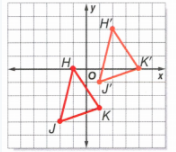
It is given that the figure is translated 3 units on the right and 3 units to the up. Translation horizontally affects the x-axis and vertically affects the y-axis.
As given; H=(−1,0) J=(−2,−4) K=(1,−3)
Therefore after translations, the values would be
H′=(−1+3,0+3)
H′ =(2,3)
J′=(−2+3,−4+3)
J′=(1,−1)
K′=(1+3,−3+3)
K′ =(4,0)
Thereby the graph can be plotted as;
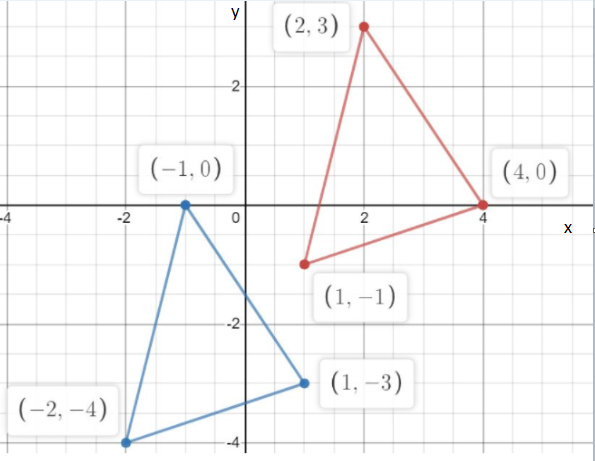
The triangle was transformed as given in the question and plotted as shown in the graph.

Page 459 Exercise 10 Problem1
We are provided with the following figure.
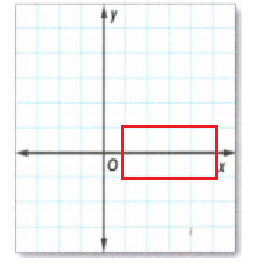
It is given that the figure is translated as 4 units on the left and 3 units to the up.
Translation horizontally affects the x-axis and vertically affects the y-axis.
As given;
K=(1,−1)
∴K′⇒(1−4,−1+3)=(−3,2)
L=(1,1)
∴L′⇒(1−4,1+3)=(−3,4)
M=(5,1)
∴M′⇒(5−4,1+3)=(1,4)
N=(5,−1)
∴N′⇒(5−4,−1+3)=(1,2)
Graphing the following;

The rectangle was transformed as given in the question and plotted as shown in the graph.

Page 459 Exercise 11 Problem1
We are provided with the following figure coordinates.
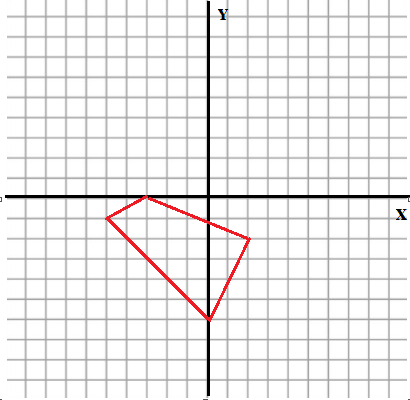
It is given that the figure is translated 4 units to the up. Translation horizontally affects the x-axis and vertically affects the y-axis.
As given; A=(−5,−1)
∴A′⇒(−5,−1+4)=(−5,3)
B=(−3,0)
∴B′⇒(−3,0+4)=(−3,4)
C=(2,−2)
∴C′⇒(2,−2+4)=(2,2)
∴D′⇒(0,−6+4)=(0,−2)
The coordinates of the vertices of the quadrilateral are
Page 459 Exercise 12 Problem1
We are provided with the following figure coordinates.
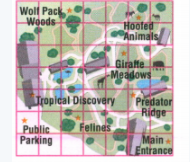
Julio is at Felines(3,1) and then moves 3 units right and 5 units up as given Translation horizontally affects the x-axis and vertically affects the y-axis.
Julio is located at Felines(3,1).
After he moved the given position he is at coordinate as;(3+3,1+5)=(6,6)
This means that he is now at Hooted animals(6,6).
After all the calculations we conclude that Julio is now at Hooted Animals(6,6).
Page 459 Exercise 13 Problem1
We are provided with the following figure coordinates.

We have to find how many translations are there using repeated reasoning. Clearly, we can observe that one helix is translated5
for the figure to form as shown.

After clear observation and reasoning, we can say that there are 5 translations.

Page 459 Exercise 14 Problem1
We are provided with the following figures.
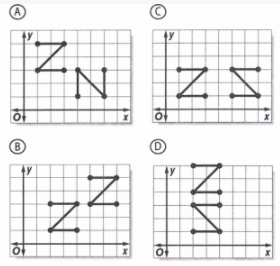
In the following, only one of the graphs shows the real example of translation.
Translation defines transposing the figure to a different coordinate to make an exact copy of it.
We can clearly see that in this particular option the word ‘Z’ is transposed from(2,1) to (5,3) to make an exact copy of it.

In the following options:
(A) shows rotation.
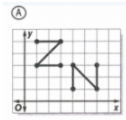
(C) shows mirror imaging.

(D) shows reflection.
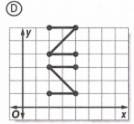
Hence cannot be the correct answers.
After final observations, it was found that option(B) was the correct option.
Page 460 Exercise 15 Problem1
We are provided with the following figure coordinateA=(−1,2).
It is given that it moves 4 units left and 3 units up as given.
Translation horizontally affects the x-axis and vertically affects the y-axis.
We are given that A(−1,2)
After translation;
A′=(−1−4,2+3)
=(−5,5)
A′ =(−5,5)
This is represented by option (G).
In the last step, we clearly saw that the value of the point after translation is A′ =(−5,5).
Therefore, the other options are not correct as the correct answer is given by option (G).
After calculation, we have observed that the correct answer is given by option(G).
Page 460 Exercise 16 Problem1
We are provided with the following figure coordinate.
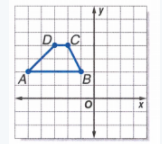
It is given that it moves 3 units right and 7 units down as given. Translation horizontally affects the x-axis and vertically affects the y-axis.
Clearly, we can calculate the coordinate of the vertices of the trapezium.
A=(−6,2)
∴A′ ⇒(−6+3,2−7)=(−3,−5)
A′=(−3,−5)
B=(−1,2)
∴B′⇒(−1+3,2−7)=(2,−5)
B′ =(2,−5)
C=(−2,4)
∴C′⇒(−2+3,4−7)=(1,−3)
C′ =(1,−3)
D=(−3,4)
∴D′⇒(−3+3,4−7)=(0,−3)
D′ =(0,−3)
After the calculations, we can conclude that the coordinates of the A′B′C′D′is(−3,−5);(2,−5);(1,−3);(0,−3).
Page 460 Exercise 17 Problem1
The given problem is−5+12
We have to find its result. Clearly, by adding them we get the value as 7.
After calculations, we conclude that the value of the sum is 7.
Page 460 Exercise 18 Problem1
The given equation is
We can use the BODMAS RULE to calculate the value of this problem. When a negative number is multiplied by a positive number, the result is always negative.
We can use the BODMAS RULE to calculate the value of this problem.
−36+(−42)
=−36−42
=−78
Finally, we can deduce that the above equation’s sum is −78.
Page 460 Exercise 19 Problem1
The given problem is256+(−82).
We have to find its result. Clearly, by adding them we get the value as256−82 =174.
After calculations, we conclude that the value of the sum is 174.
Page 460 Exercise 20 Problem1
We have been given two numbers. We need to find the sum of these two numbers.
This can be found by subtracting the two numbers and then putting the sign with the larger number in the answer.
−452+97
=−(452−97)
=−355
The sum of the given numbers is -355.
